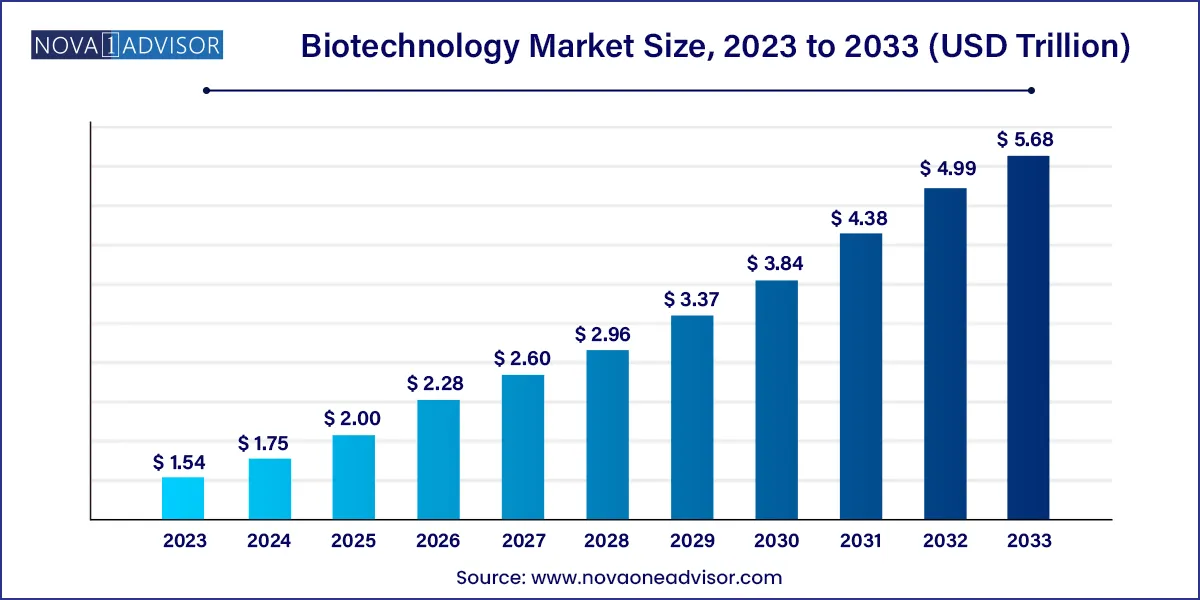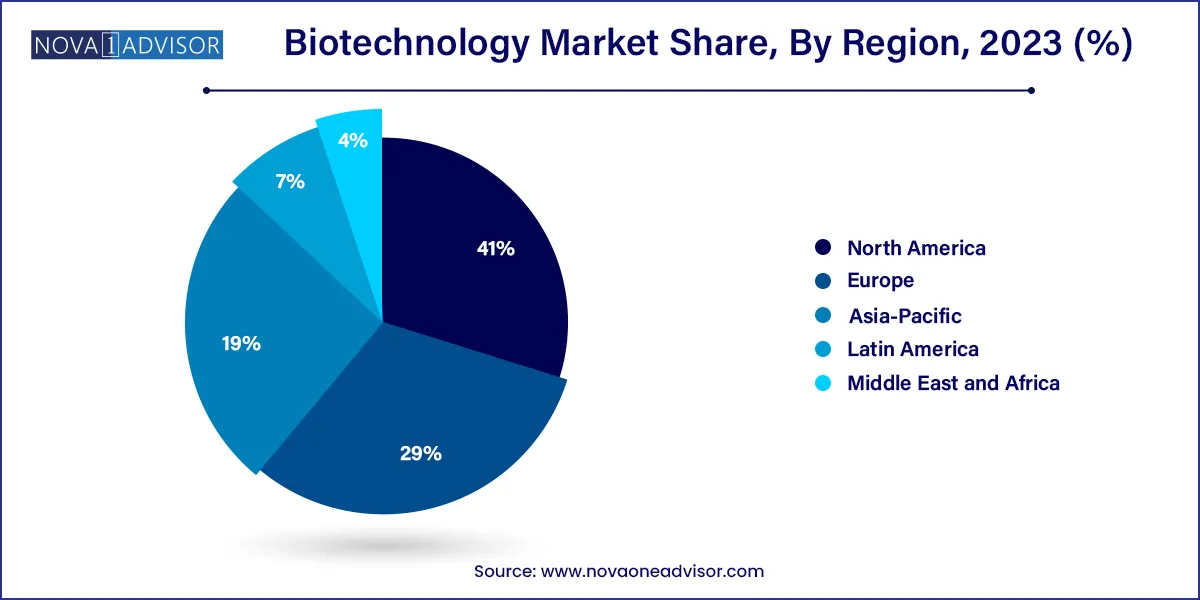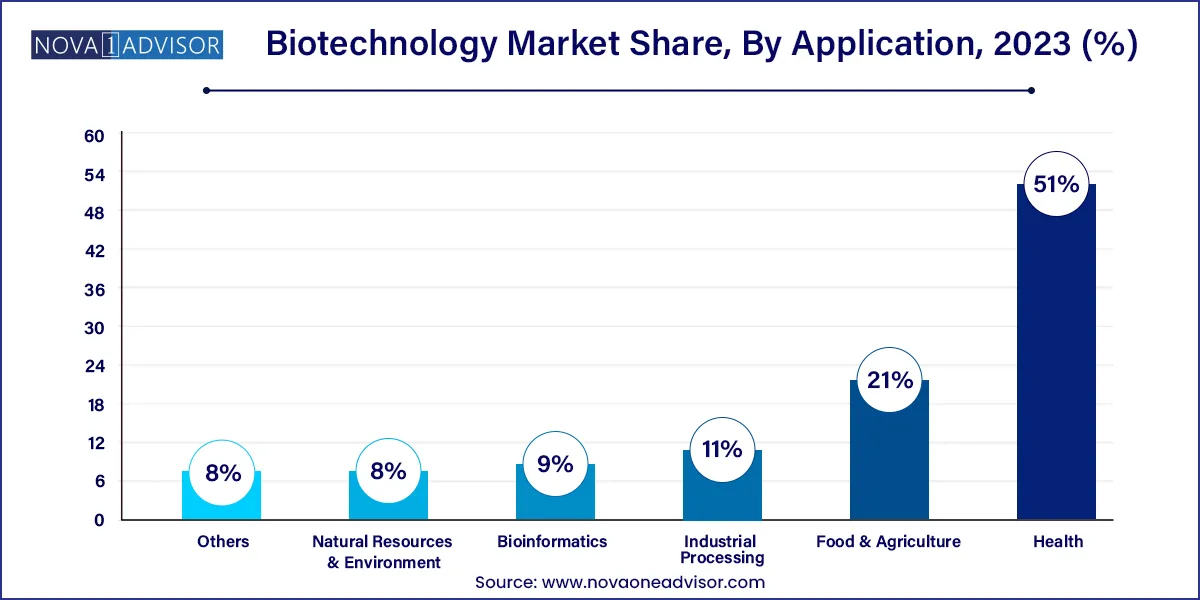The global biotechnology market size was estimated at USD 1.54 Trillion in 2023 and is projected to hit around USD 5.68 Trillion by 2033, growing at a CAGR of 13.95% during the forecast period from 2024 to 2033.

Key Takeaways:
- North America accounted for the largest share of 41% in 2023.
- Asia Pacific is expected to expand at the fastest growth rate from 2024 to 2033.
- DNA sequencing held a significant market share of 17.53% in 2023
- Nanobiotechnology is expected to grow at a significant growth rate from 2024 to 2033
- The health application segment accounted for the largest share 51% in 2023.
- The growing demand for biosimilars and rising applications of precision medicine are expected to boost segment growth during the forecast period.
Biotechnology Market in the U.S. 2024 to 2033
The U.S. biotechnology market size was valued at USD 0.44 Trillion in 2023 and is anticipated to reach around USD 1.67 Trillion by 2033, growing at a CAGR of 14.28% from 2024 to 2033.
.webp)
North America, particularly the United States, dominates the global biotechnology market due to its robust R&D infrastructure, high healthcare expenditure, and well-established regulatory environment. The U.S. is home to biotech giants like Amgen, Gilead, and Biogen, as well as thousands of startups funded by a vibrant venture capital ecosystem. Federal initiatives like the NIH, BARDA, and the National Cancer Institute fund significant biotech research. The region also benefits from top-tier academic institutions and biotech clusters in Boston, San Francisco, and San Diego. Regulatory support from the FDA’s Breakthrough Therapy Designation and Accelerated Approval pathways has fueled innovation and market access.

Asia-Pacific is the fastest-growing region, led by countries like China, India, Japan, and South Korea. China’s strategic investments in genomics, gene therapy, and biopharmaceuticals under the “Made in China 2025” policy are yielding rapid growth. India is emerging as a major hub for vaccine manufacturing, diagnostics, and generic biologics due to its cost advantages and skilled workforce. Japan’s aging population is increasing demand for regenerative medicine and personalized care. Regional governments are offering tax incentives, establishing biotech parks, and simplifying regulatory pathways. As domestic consumption and innovation capacities rise, Asia-Pacific is poised to reshape the global biotech landscape.
Market Overview
The biotechnology market represents one of the most transformative and rapidly evolving sectors of the global economy, bridging life sciences, engineering, and information technology to drive innovations in healthcare, agriculture, energy, and environmental sciences. Rooted in the manipulation of biological systems and organisms for commercial use, biotechnology has expanded from traditional applications like fermentation and crop breeding to cutting-edge areas such as gene editing, nanobiotechnology, regenerative medicine, and synthetic biology.
At its core, biotechnology harnesses cellular and biomolecular processes to develop products that improve human life and the planet. In healthcare, biotechnology has enabled the creation of life-saving biologics, mRNA vaccines, targeted therapies, and diagnostics. In agriculture, it enhances crop yield, pest resistance, and soil quality. Environmental biotechnology is pivotal for waste treatment, bioremediation, and biofuel production. With global challenges like pandemics, food insecurity, climate change, and antibiotic resistance, biotechnology offers novel tools to create scalable, sustainable solutions.
The market's growth is being propelled by increased R&D investments, favorable regulatory frameworks, breakthroughs in omics technologies, and the integration of artificial intelligence in biological data analysis. From startups leveraging CRISPR for rare disease therapies to global pharma giants investing in advanced biologics manufacturing, the industry is seeing diversified expansion across applications and geographies.
Biotechnology’s convergence with digital health, precision agriculture, and green industrial processes ensures its relevance across multiple verticals. As the demand for personalized healthcare, clean energy, and climate-resilient farming intensifies, biotechnology is set to play an even more central role in shaping global economies and societies.
Major Trends in the Market
-
Explosive Growth of mRNA and Gene Therapies: Post-COVID-19, mRNA platforms and gene-editing tools like CRISPR are reshaping therapeutics and vaccines.
-
Rise of Synthetic Biology: Companies are designing custom organisms for material science, fuel, and food innovations.
-
Increased Investment in Agricultural Biotech: Drought-resistant, nitrogen-efficient, and genetically engineered crops are expanding.
-
Miniaturization Through Nanobiotechnology: Targeted drug delivery, biosensors, and diagnostic nanodevices are in rapid development.
-
Regenerative Medicine and 3D Bioprinting Surge: Tissue engineering is gaining traction for organ repair, wound healing, and musculoskeletal regeneration.
-
Bioinformatics Integration with AI and Cloud: Huge genomic datasets are being processed with machine learning to accelerate drug discovery.
-
Focus on Sustainability and Bio-based Manufacturing: Industrial biotech is replacing petroleum-based processes with enzyme-driven fermentation.
-
Increased Public-Private Collaborations: Government grants, academic partnerships, and biotech accelerators are fostering innovation pipelines.
Biotechnology Market Report Scope
| Report Attribute |
Details |
| Market Size in 2024 |
USD 1.75 Trillion |
| Market Size by 2033 |
USD 5.68 Trillion |
| Growth Rate From 2024 to 2033 |
CAGR of 13.95% |
| Base Year |
2023 |
| Forecast Period |
2024 to 2033 |
| Segments Covered |
Technology, application, region |
| Market Analysis (Terms Used) |
Value (US$ Million/Billion) or (Volume/Units) |
| Report Coverage |
Revenue forecast, company ranking, competitive landscape, growth factors, and trends |
| Key Companies Profiled |
AstraZeneca, Gilead Sciences, Inc., Bristol-Myers Squibb, Biogen, Abbott Laboratories, Amgen Inc., Novo Nordisk A/S, Merck KGaA., Johnson & Johnson Services, Inc., Novartis AG, Sanofi, F. Hoffmann-La Roche Ltd., Pfizer, Inc., Lonza |
Market Driver: Rising Demand for Personalized and Targeted Therapies
A key driver of the biotechnology market is the increasing demand for personalized and precision medicine, which uses an individual’s genetic, environmental, and lifestyle information to tailor treatments. This paradigm shift is possible due to advancements in genomic sequencing, proteomics, and biomarker discovery—core areas within biotechnology.
For example, oncology treatments now use companion diagnostics to identify specific mutations in tumor DNA, ensuring patients receive targeted therapies with higher efficacy and lower toxicity. CAR-T cell therapy for blood cancers is a prime illustration of personalized medicine made possible by genetic engineering and cell therapy tools. Furthermore, conditions like cystic fibrosis and spinal muscular atrophy are being managed using gene therapies that address the root cause at the molecular level.
As public health systems and insurers emphasize value-based care, biotechnology solutions that offer individualized treatment and better outcomes are gaining traction. The ability to design therapies around a patient’s genetic blueprint is redefining drug development and regulatory models, significantly boosting the sector’s growth.
Market Restraint: High Development Costs and Regulatory Complexity
Despite its immense potential, the biotechnology market is restrained by high R&D costs, lengthy product development timelines, and complex regulatory pathways. Developing a single biotech drug can cost between $1 billion to $2 billion and take over a decade from discovery to market approval. Biologics, gene therapies, and regenerative treatments require specialized facilities, stringent clinical trials, and long safety evaluations.
Additionally, regulatory agencies like the FDA, EMA, and PMDA impose rigorous data standards, especially for novel biologics, cell-based products, or genetically modified organisms (GMOs). Navigating these frameworks requires significant expertise and resources, often limiting market entry for smaller companies. IP protection, pricing debates, and ethical concerns especially around gene editing and cloning add further layers of complexity.
These challenges can delay commercialization, increase investment risk, and limit patient access. Overcoming them requires collaborative engagement between regulators, academia, and industry stakeholders to create agile yet safe innovation environments.
Market Opportunity: Expansion of Biotechnology in Environmental and Industrial Applications
An exciting opportunity lies in the rapid expansion of biotechnology into industrial and environmental sectors, particularly in the context of sustainability. With global attention on climate change, pollution, and resource scarcity, biotech solutions offer greener alternatives to traditional processes.
Industrial biotechnology uses microorganisms and enzymes in fermentation to produce chemicals, materials, and fuels. Companies are developing bio-based plastics, biodegradable packaging, and enzyme-catalyzed synthesis routes that reduce the environmental footprint of manufacturing. For instance, startups are using algae and bacteria to produce biopolymers that replace petroleum-based plastics.
Similarly, environmental biotechnology is vital for waste management, water purification, and soil remediation. Bioengineered microbes can clean oil spills, remove heavy metals, and degrade toxic chemicals. Biofuel production using lignocellulosic biomass and algae also represents a major opportunity, especially with government incentives for clean energy.
As ESG (Environmental, Social, and Governance) metrics become central to corporate strategies, industries are turning to biotechnology for innovation that aligns with sustainability goals—unlocking new revenue streams beyond healthcare.
Biotechnology Market ByTechnology Insights
DNA sequencing is the dominant technology in the biotechnology market, driven by its foundational role in genomics, diagnostics, and drug discovery. Next-generation sequencing (NGS) has revolutionized biology by enabling rapid, affordable genome mapping. It’s used in everything from cancer diagnostics and rare disease identification to agricultural genomics and microbiome analysis. Companies like Illumina, Thermo Fisher Scientific, and Pacific Biosciences have transformed sequencing into a clinical and research staple. Sequencing enables gene editing, personalized medicine, and population health research, making it a critical pillar of biotechnology advancement.
Conversely, nanobiotechnology is the fastest-growing technology segment, offering transformative potential across healthcare, diagnostics, and environmental monitoring. This field integrates nanotechnology with biological systems to create nanoscale drug delivery systems, biosensors, diagnostic tools, and imaging agents. For instance, nanoparticles are being engineered to deliver chemotherapy drugs directly to tumors, minimizing systemic toxicity. In diagnostics, nanobiosensors can detect diseases at earlier stages by identifying biomarkers in real time. Nanobiotech is also emerging in agriculture and water purification, making it one of the most versatile and promising subfields in biotech innovation.
Biotechnology Market By Application Insights
Health biotechnology remains the largest application segment, encompassing pharmaceuticals, diagnostics, vaccines, and gene/cell therapies. The COVID-19 pandemic accelerated innovation and adoption of health biotech tools such as mRNA vaccines (Pfizer-BioNTech, Moderna) and antibody-based treatments. Chronic diseases like cancer, diabetes, and neurodegenerative disorders continue to drive demand for biopharmaceutical innovation. Technologies like CRISPR, AI-driven drug discovery, and regenerative medicine are fueling a new era in clinical care. Companies are using 3D printing for tissue scaffolds, synthetic biology for vaccine development, and cell therapy for immune modulation, solidifying health biotech’s dominance.

Industrial processing is the fastest-growing application, as biotech expands into green manufacturing, energy, and chemical production. Microbial fermentation, enzyme catalysts, and metabolic engineering are enabling cost-efficient, sustainable alternatives to petrochemical processes. Bioethanol, bioplastics, biosurfactants, and other renewable compounds are gaining commercial traction. Biotech companies are collaborating with manufacturing firms to replace energy-intensive methods with bio-based processes that reduce carbon footprints and waste. As global industries face mounting sustainability pressures, biotechnology offers an economically viable and environmentally friendly alternative.
Biotechnology Market Recent Developments
-
April 2025: Moderna announced a Phase II trial for its mRNA-based personalized cancer vaccine in collaboration with Merck, showcasing the expansion of mRNA technology beyond infectious diseases.
-
February 2025: Illumina launched a new ultra-high-throughput sequencing system designed to accelerate population genomics projects and rare disease research.
-
December 2024: CRISPR Therapeutics received FDA Fast Track Designation for its gene-editing therapy targeting Duchenne muscular dystrophy.
-
October 2024: Bayer AG announced a $1 billion expansion into agri-biotech, focusing on CRISPR-based plant gene editing and RNA interference pest control.
-
August 2024: Ginkgo Bioworks partnered with Dow Chemical to develop bioengineered enzymes for industrial adhesives, signaling biotech’s penetration into chemical manufacturing.
Some of the prominent players in the Biotechnology Market include:
- AstraZeneca
- Gilead Sciences, Inc.
- Bristol-Myers Squibb
- Sanofi
- Biogen
- Abbott Laboratories
- Pfizer, Inc.
- Amgen Inc.
- Novo Nordisk A/S
- Merck KGaA
- Johnson & Johnson Services, Inc.
- Novartis AG
- F. Hoffmann-La Roche Ltd.
- Lonza
Biotechnology Market Segments Covered in the Report
This report forecasts revenue growth at country levels and provides an analysis of the latest industry trends in each of the sub-segments from 2021 to 2033. For this study, Nova one advisor, Inc. has segmented the Biotechnology market.
By Technology
- Nanobiotechnology
- Tissue Engineering and Regeneration
- DNA Sequencing
- Cell-based Assays
- Fermentation
- PCR Technology
- Chromatography
- Others
By Application
- Health
- Food & Agriculture
- Natural Resources & Environment
- Industrial Processing
- Bioinformatics
- Others
By Region
- North America
- Europe
- Asia-Pacific
- Latin America
- Middle East & Africa (MEA)


.webp)

